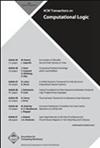信息流逻辑中的输入、输出和构成
IF 0.9
4区 数学
Q3 COMPUTER SCIENCE, THEORY & METHODS
ACM Transactions on Computational Logic
Pub Date : 2023-07-15
DOI:https://dl.acm.org/doi/10.1145/3604553
引用次数: 0
摘要
信息流逻辑(LIF)是一个通用框架,在该框架中,可以以声明性的、基于逻辑的方式对具有过程性质的任务进行建模。本文的第一个贡献是提出了LIF表达式输入和输出的语义和语法定义。我们研究了这两者之间的关系,并表明我们的句法定义在某种意义上是最优的,它是精确的。第二个贡献是对LIF中顺序构图表达能力的系统研究。我们关于组合的结果与输入和输出的结果相联系,并将LIF与一阶逻辑(FO)和有界变量LIF与有界变量FO联系起来。本文是在KR 2020[2]上发表的一篇论文的扩展版本。本文章由计算机程序翻译,如有差异,请以英文原文为准。
Inputs, Outputs, and Composition in the Logic of Information Flows
The logic of information flows (LIF) is a general framework in which tasks of a procedural nature can be modeled in a declarative, logic-based fashion. The first contribution of this paper is to propose semantic and syntactic definitions of inputs and outputs of LIF expressions. We study how the two relate and show that our syntactic definition is optimal in a sense that is made precise. The second contribution is a systematic study of the expressive power of sequential composition in LIF. Our results on composition tie in the results on inputs and outputs, and relate LIF to first-order logic (FO) and bounded-variable LIF to bounded-variable FO.
This paper is the extended version of a paper presented at KR 2020 [2].
求助全文
通过发布文献求助,成功后即可免费获取论文全文。
去求助
来源期刊

ACM Transactions on Computational Logic
工程技术-计算机:理论方法
CiteScore
2.30
自引率
0.00%
发文量
37
审稿时长
>12 weeks
期刊介绍:
TOCL welcomes submissions related to all aspects of logic as it pertains to topics in computer science. This area has a great tradition in computer science. Several researchers who earned the ACM Turing award have also contributed to this field, namely Edgar Codd (relational database systems), Stephen Cook (complexity of logical theories), Edsger W. Dijkstra, Robert W. Floyd, Tony Hoare, Amir Pnueli, Dana Scott, Edmond M. Clarke, Allen E. Emerson, and Joseph Sifakis (program logics, program derivation and verification, programming languages semantics), Robin Milner (interactive theorem proving, concurrency calculi, and functional programming), and John McCarthy (functional programming and logics in AI).
Logic continues to play an important role in computer science and has permeated several of its areas, including artificial intelligence, computational complexity, database systems, and programming languages.
The Editorial Board of this journal seeks and hopes to attract high-quality submissions in all the above-mentioned areas of computational logic so that TOCL becomes the standard reference in the field.
Both theoretical and applied papers are sought. Submissions showing novel use of logic in computer science are especially welcome.
 求助内容:
求助内容: 应助结果提醒方式:
应助结果提醒方式:


